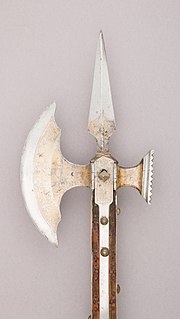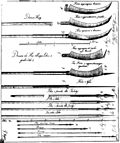A polearm or pole weapon is a close combat weapon in which the main fighting part of the weapon is fitted to the end of a long shaft, typically of wood...
26 KB (3,582 words) - 20:55, 14 August 2024
The three most common types of Chinese polearms are the ge (戈), qiang (槍), and ji (戟). They are translated into English as dagger-axe, spear, and halberd...
15 KB (1,588 words) - 23:11, 17 April 2024
English approximation: /dʒiː/ jee, Chinese: 戟; pinyin: jǐ) was a Chinese polearm, sometimes translated into English as spear or halberd, though they are...
6 KB (642 words) - 08:10, 29 July 2024
Poleaxe (redirect from Pollaxe (Polearm))
poleaxe (also pollaxe, pole-axe, pole axe, poleax, polax) is a European polearm that was used by medieval infantry. Most etymological authorities consider...
7 KB (868 words) - 08:56, 4 June 2024
Many of the polearms used in Scotland up to the beginning of the 16th century were similar to those used in other parts of the world; however, a number...
3 KB (348 words) - 05:22, 22 April 2022
Bill (weapon) (redirect from Bill (polearm))
trimming tree limbs, which was often repurposed for use as an infantry polearm. In English, the term 'Italian bill' is applied to the similar roncone...
5 KB (685 words) - 11:38, 15 March 2024
Ngao (ง้าว,ของ้าว) is a polearm that was traditionally used during the 18th century in Thailand. Stick fighting List of premodern combat weapons List...
719 bytes (58 words) - 19:41, 11 June 2024
Halberd (category Medieval polearms)
halberd (also called halbard, halbert or Swiss voulge) is a two-handed polearm that came to prominent use from the 13th to 16th centuries. The halberd...
18 KB (2,191 words) - 20:03, 21 September 2024
Lucerne hammer (category Medieval polearms)
The Lucerne hammer (/luˈsɜːrn/ loo-SURN) is a type of polearm which was popular in Swiss armies during the 15th to 17th centuries. It was a combination...
2 KB (218 words) - 12:29, 14 June 2024
Naginata (category Polearms of Japan)
The naginata (なぎなた, 薙刀) is a polearm and one of several varieties of traditionally made Japanese blades (nihontō). Naginata were originally used by the...
21 KB (2,166 words) - 09:32, 24 August 2024
War scythe (category Polearms)
A war scythe or military scythe is a form of polearm with a curving single-edged blade with the cutting edge on the concave side of the blade. Its blade...
7 KB (831 words) - 14:25, 13 June 2024
Partisan (weapon) (category Polearms)
the free dictionary. A partisan (also known as a partizan), a type of polearm, was used in Europe during the 16th, 17th, and 18th centuries. It consisted...
3 KB (249 words) - 05:09, 11 July 2024
Fauchard (category Polearms)
A fauchard is a type of polearm which was used in Europe from the 11th through the 17th centuries. In later use fauchards became ornamental and ceremonial...
6 KB (610 words) - 09:49, 28 June 2024
Bardiche (category Medieval polearms)
bardiche /bɑːrˈdiːʃ/, berdiche, bardische, bardeche, or berdish is a type of polearm used from the 14th to 17th centuries in Europe. Ultimately a descendant...
6 KB (715 words) - 04:29, 24 July 2024
Sovnya (category Polearms)
A sovnya (‹See Tfd›Russian: совня) is a traditional polearm used in Russia. Similar to the glaive, the sovnya had a curved, single-edged blade mounted...
1 KB (94 words) - 18:17, 15 March 2024
An assegai or assagai is a polearm used for throwing, usually a light spear or javelin made up of a wooden handle with an iron tip. The use of various...
4 KB (315 words) - 18:37, 5 October 2024
Dagger-axe (category Chinese polearms)
The dagger-axe (Chinese: 戈; pinyin: gē; Wade–Giles: ko) is a type of polearm that was in use from the Longshan culture until the Han dynasty in China...
5 KB (557 words) - 22:45, 17 April 2024
Ranseur (category Polearms)
A ranseur, also called roncone, was a polearm similar to the partisan used in Europe up to the 15th century. It was still seen in court as a ceremonial...
1 KB (176 words) - 11:15, 17 April 2024
Spetum (category Polearms)
A spetum is a polearm that was used in Europe during the 13th century. Other names include chauve souris, corseca, corsèsque, korseke, runka, and rawcon...
2 KB (295 words) - 07:02, 27 August 2024
Spear (category Polearms)
A spear is a polearm consisting of a shaft, usually of wood, with a pointed head. The head may be simply the sharpened end of the shaft itself, as is...
49 KB (6,129 words) - 05:17, 20 August 2024
Guandao (category Chinese polearms)
A guandao is a type of Chinese polearm that is used in some forms of Chinese martial arts. In Chinese, it is properly called a yanyuedao (偃月刀; lit. "reclining...
11 KB (1,591 words) - 21:58, 24 September 2024
Spontoon (category Medieval polearms)
the variant spelling espontoon or as a half-pike, is a type of European polearm that came into being alongside the pike. The spontoon was in common use...
4 KB (595 words) - 11:35, 17 April 2024
Glaive (category Medieval polearms)
distinctive design and versatile combat applications. There are many similar polearms such as the war scythe, the Japanese naginata, the Chinese guandao (yanyuedao)...
8 KB (1,039 words) - 06:49, 27 August 2024
Lochaber axe (category Medieval polearms)
defense against cavalry and as a pike against infantry. Like most other polearms of the time, it consisted of two parts: shaft and blade. The shaft was...
5 KB (567 words) - 12:47, 17 September 2024
Voulge (category Polearms)
(also spelled vouge, sometimes called a couteau de breche) is a type of polearm that existed in medieval Europe, primarily in 15th century France. A voulge...
3 KB (295 words) - 11:32, 17 April 2024
Monk's spade (category Chinese polearms)
Japanese: getsugasan; "Zen Staff"), also called a Shaolin Spade, is a Chinese polearm consisting of a long pole with a flat spade-like blade on one end and a...
2 KB (210 words) - 01:34, 18 June 2024
Kumar and Trisha Ji (monk) (632–682), Chinese monk Ji (polearm) (戟), a kind of Chinese polearm Ji Koizumi, a character in the anime Guru Guru Pon-chan...
2 KB (345 words) - 19:52, 20 August 2024
Guisarme (category Polearms)
A guisarme (sometimes gisarme, giserne or bisarme) is a polearm used in Europe primarily between 1000 and 1400. Its origin is likely Germanic, from the...
4 KB (532 words) - 11:28, 17 April 2024
Man catcher (category Polearms)
A man catcher, also known as catchpole, is a type of polearm. It was used in Europe as late as the 18th century.[citation needed] The European design...
5 KB (636 words) - 12:33, 14 June 2024
may fit more than one category (e.g. the spear may be used either as a polearm or as a projectile), and the earliest gunpowder weapons which fit within...
30 KB (2,620 words) - 04:34, 30 July 2024























